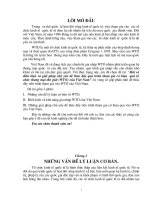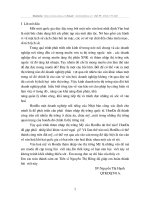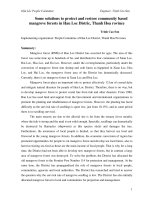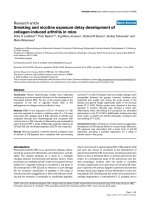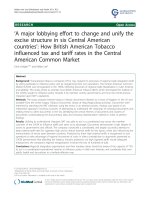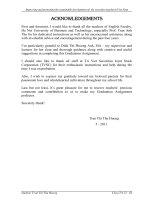some solutions to improve and enhance the sustainable development of the securities market in viet nam
Bạn đang xem bản rút gọn của tài liệu. Xem và tải ngay bản đầy đủ của tài liệu tại đây (280.07 KB, 33 trang )
Improving and promoting the sustainable development of the securities market in Viet Nam
Acknow ledgements
First and foremost, I would like to thank all the teachers of English Faculty,
Ha Noi University of Business and Technology, especially Prof. Tran Anh
Tho for his dedicated instructions as well as his unconcerned assistance along
with invaluable advice and encouragement during the past four years.
I’m particularly grateful to Dinh Thi Phuong Anh, MA – my supervisor and
lecturer for her clear and thorough guidance along with creative and useful
suggestions in completing this Graduation Assignment.
I should also like to thank all staff at Tri Viet Securities Joint Stock
Corporation (TVSC) for their enthusiastic instructions and help during the
time I was on probation.
Also, I wish to express my gratitude toward my beloved parents for their
passionate love and wholehearted cultivation throughout my school life.
Last but not least, it’s great pleasure for me to receive teachers’ precious
comments and contribution so as to make my Graduation Assignment
perfecter.
Sincerely thank!
Tran Thi Thu Huong
5 - 2011
Student: Tran Thi Thu Huong Class TA 12 - 02
Improving and promoting the sustainable development of the securities market in Viet Nam
TABLE OF ConteN TS
ACKNOWLEDGEMENTS
VN-INDEX = X 100
11
Student: Tran Thi Thu Huong Class TA 12 - 02
Improving and promoting the sustainable development of the securities market in Viet Nam
Abbrev iatio ns
1. OTC : Over the counter market
2. NSC : National Securities Commission
3. SE : Stock Exchange
4. FI : Financial intermediaries
5. ATO : At the open order
6. ATC : At the close order
7. PM : Portfolio Management
8. SSC : State Securities Commission
9. STC : Securities Trading Center
10. HOSTC : Ho Chi Minh City Securities Trading Center
11. HASTC : Ha Noi Securities Trading Center
12. UPCOM : Unlisted Public Company Market
13. SDC : Securities Depository Center
14. IOSCO : International Organization of Securities Commissions
15. SOE : State owned Enterprise
Student: Tran Thi Thu Huong Class TA 12 - 02
Improving and promoting the sustainable development of the securities market in Viet Nam
INTRODUCTION
To implement the industrialization and modernization of the country,
maintain the pace of sustainable economic growth and a strong shift of
economic structure towards improving efficiency and competitiveness require
great capital for investment and development. Therefore, the establishment of
securities markets in Viet Nam is a the main objective of the economy
because the economic trend in the market mechanism under the State
management is not reversible.
Securities market is an important channel to attract long term capital for
enterprises in order to improve competitiveness in the fast growing
commodity economy like our country. Also, the stock market along with the
banking system will create a strong financial system providing the short,
medium and long term funds for the economy. Moreover, politically and
diplomatically, the construction of the securities market has very positive
impact on the process of integration into the regional and international
community.
Since its foundation, the securities market has made a great contribution
to the economy. However, there have been still exited limitations hindering
the market development. So how to deal with problems of the securities
market and create positive solutions to promote the sustainable growth of the
securities market in Viet Nam is a very practical and urgent matter. To my
best knowledge, I would like to give my opinion on the topic: “Improving and
promoting the sustainable development of the securities market in Viet Nam”.
The assignment is divided into:
Introduction
Chapter 1: Overview of the securities market.
Chapter2: The situation of the securities market in Viet Nam.
Chapter 3: Some solutions for improving and enhancing the sustainable
development of the securities market in Viet Nam.
Conclusion
Student: Tran Thi Thu Huong Class TA 12 - 02
1
Improving and promoting the sustainable development of the securities market in Viet Nam
chapter 1
OVERVIEW OF TH E SECURITIES MARK ET
1.1. The b asic knowl edge on the secur ities mark et
The securities market is considered a center of the modern corporate
economy nowadays. In the developed economies, the securities market was
established more than 100 years ago and has become an important part of the
socio-economic life. An effective securities market will create many
opportunities for people to invest their savings as well as channels to mobilize
domestic and foreign capitals to provide funds to successful businesses. Many
countries in the transition from central planning economies to the market ones
have used securities market as a channel to efficiently mobilize capitals for
enterprises. In the renovation process of the market oriented economy, the
securities market in Viet Nam also was established and developed about a
decade ago.
1.1.1. The concept of the securities market
Securities market is an financial organization where the sale and
purchase transactions of securities take place.
The securities market in many cases is the same name as the stock
exchange. Basically, the stock exchange is an organization (or company)
whose function is to link the buyers and the sellers and help them implement
transactions. The stock exchange is considered important in the modern
market economies.
1.1.2 Commodities and their characteristics in the securities market
1.1.2.1 Commodities in the securities market
Securities are the kind of long-term financial instruments, including stocks
and bonds and derivatives.
a, Stocks.
Stock means a certificate confirming a person's capital contribution and
ownership to joint stock companies.
The owners are called shareholders who have the authority and
responsibility for joint stock companies, enjoying the shares of profits
(dividends) under business results of the company, have the right to
vote in the Annual General Meeting.
Student: Tran Thi Thu Huong Class TA 12 - 02
2
Improving and promoting the sustainable development of the securities market in Viet Nam
Stocks may be issued at established companies, or at any time to
mobilize more capital to expand and modernize the businesses.
b, Bonds
A bond is a debt security which guarantees to repay the principal of the
loan plus interest to the bondholders.
Bonds are considered to be a long-term debt and have to be paid back
on their maturity date. Usually bonds have fixed interest rate, which is
paid to the bondholders depending on the terms of the bond.
Bonds can be issued by both governments and corporations.
c, Derivative Securities
Derivatives are issued on the basis of available instruments such as
stocks and bonds with many different targets such as risk dispersion
and protection of profits or profit making.
The derivatives will be a lever, increasing many times the value of the
investment objects such as stocks and bonds, to ensure that if how
much the price of stocks and bonds change, the price of derivatives
will be maintained at the original.
The derivatives are plentiful and varied, but generally there are four
main tools: the contracts of forward, future, option and swap.
1.1.2.2 Commodities’ features in the securities market
a, Liquidity
The ability to convert securities into cash.
b. Risk:
Securities are financial assets whose value is suffered from large impact of
risk, which is not only a loss of spirit, but also the expectations of investors.
There are two types of risk: systematic risk and unsystematic risk
Systematic risk: This risk is unavoidable, affecting all or most types of
securities due to the influence of economic conditions such as inflation
or deflation, changes in exchange rates, interest rate Systemic risks
include:
• Interest rate risk: is profit’s fluctuations because of interest rate
changes in the market.
• Market risk: means the market prices of securities may fluctuate
strongly due to the assessment and decision making of investors,
Student: Tran Thi Thu Huong Class TA 12 - 02
3
Improving and promoting the sustainable development of the securities market in Viet Nam
although the company's income has not changed.
• Purchasing power risk: due to the impact of inflation or
deflation.
• Exchange rate risk: due to the change of exchange rate.
Unsystematic risk: the risk only impacts on a stock or a certain group
of securities. Systemic risks include:
• Business risks: means adverse changes on the supply and
demand of goods or services of enterprises.
• Financial Risk: The risk of ability to pay dividends, relating to
the imbalance between revenue, expenses and debts of the
businesses.
• Risk management: the impact of the managers’ decisions of the
businesses.
c, Profitability
Securities are the property which owners will earn income in the future in
annual income and profits because of the stock price’s increase.
1.1.3 Classification of the securities market
1.1.3.1 Classified by the market’s operating tools and commodities
a. Bond market
The bond market (also known as the debt, credit or fixed income market)
is a financial market where participants buy and sell debt securities, usually in
the form of bonds.
b. Stock market
A stock market is a public entity for trading company stock (shares) and
derivatives at an agreed price. These are securities listed on a stock exchange.
c. Derivatives market
The derivatives market is the financial market for derivatives, financial
instruments like futures contracts or options, which are derived from other
forms of assets.
1.1.3.2 Classified by the movement of capital
a. Primary market
The primary market is that part of the capital markets that deals with
the issuance of new securities which is called an initial public offering (IPO).
Student: Tran Thi Thu Huong Class TA 12 - 02
4
Improving and promoting the sustainable development of the securities market in Viet Nam
Primary market creates long term instruments through which corporate
entities borrow from capital market and more revenue for the
government’s consumption purposes.
b. Secondary market
The secondary market, also called aftermarket, is the financial market
where previously issued securities and financial instruments are bought
and sold aiming making profit, moving capital and social property.
The secondary market increases liquidity, liquidity of the issued
securities helps to convert the capital.
Through auction, the prices of issued securities on the secondary market are
valued which is an important measure to evaluate the company.
1.1.3.3 Categorized by organizational form
a. Centralized market
Centralized market has headquarter, the central transaction or Stock
Exchange.
SEs are held completely with board, board of directors, others
departments function and controlled strictly under the securities laws
and stock market by state securities commission .
At stock exchanges, listed securities are traded between buyers and
sellers through a broker or securities agents.
The payment is carried by the method of multilateral clearing with the
time payment is T +1 (with the trading of bonds and 100,000 stocks or
more ), and T+3(Less than 100,000 shares).
Payment of transacting members will be transferred on the basis of the
Viet Nam Securities Depository Center carrying out clearing between
the received money and amount of payments for transactions with the
same period and payment method in the Securities Exchange.
b, Over the counter market (OTC)
OTC is the secondary market, which has no Stock Exchange, no
certain place and is operated over the phone, via the Internet or at the
counters of commercial banks or securities companies.
Securities traded on the OTC market are mainly listed unqualified
securities on a Stock Exchange, but they meet the criteria on liquidity
and the financial requirements of the market securities.
Student: Tran Thi Thu Huong Class TA 12 - 02
5
Improving and promoting the sustainable development of the securities market in Viet Nam
In the OTC market, the market maker (trading companies - brokers)
holds a certain amount of stock which are ready to make the sale.
The brokerage firms must register with the management agencies and
compliance guidelines for financial, technical and professional ethics.
Buying and selling securities prices are defined largely through
negotiation and agreement between the buyer and seller.
OTC market management: controlled strictly by the SSC under
securities laws and the relevant law and by the association of securities
dealers
1.1.4 The entities participating in the securities market
The entities participating in the securities market include both small
individual investors and the large organizations, such as government,
corporations, investment funds,… The organizations and individuals involved
in the securities market could be divided into the following groups: issuers,
investors, and the organizations related to the securities market.
The issuers: They are organizations who mobilize capital through the
securities market such as governments and local authorities with the
issuing government and local bonds; companies with the issuing
corporate shares and bonds; and financial organizations when issuing
financial tools such as bonds, other documents…
The investors: They are people who buy and sell in the securities
market. The investors could be divided into two kinds: individuals and
organizations.
The organizations operate in the securities market include securities
companies, stock investment funds and financial organizations.
In addition, there are organizations related to the securities market such
as state management agencies, stock exchanges, stock businessmen
associations,…
1.1.5 Characteristics and nature of the securities market
Due to the nature of the securities market which is a place to deal in
long-term value documents and the investment decisions are mainly
made by speculation. The securities market’s characteristic is of high
return and always associated with high risks.
Similar to any markets, the securities market is controlled by the
supply- demand rule. A change in demand will lead to a change in
supply; an increase in supply will lower prices, and increased demand
Student: Tran Thi Thu Huong Class TA 12 - 02
6
Improving and promoting the sustainable development of the securities market in Viet Nam
will raise prices. Security is also a market economy’s commodity, but
slightly different than other commodities is that securities which aren’t
bought to consume are confident that to bring profits in the future.
Therefore enterprises with good business and investment makes
securities’ demand and the company's stock rise
All countries expect to have stable securities market. One securities
market is considered a stable one and high quality must guarantee the
following factors: 1- high liquidity; 2- low risk due to price changes; 3-
effectiveness, information is disseminated rapidly and reflected into
prices; and low cost for exchange transaction.
1.1.6. The securities market’s functions
Along with the monetary market, the securities market is the premium product
of the modern economy and an important part in the financial market of each
nation contributing to the nations’ prosperous development.
The basic functions of the securities market as the followings:
Firstly, the securities market is an important capital source to help
companies to mobilize medium and long-term investment capital so as
to expand their production and business activities. This capital source
has more advantages compared to that borrowed from banks which are
usually short -term.
Secondly, the securities market provides a favorable investment
environment to the public and attracts foreign investors.
Thirdly, the securities market creates high liquidity for securities. The
securities market is a place where sellers and buyers meet and they are
guaranteed by the Law which easily encourages people to own stocks
as a profitable –making saving way and help companies and
governments mobilizing capitals easily for their investment projects.
Fourthly, the securities market helps to assess enterprises’ activities.
When one company issues and sells stocks to the people, the most
important factors deciding the added value of stocks are profit and
their potential. This information must be open so that people
(including stockholders) can monitor, assess and make investment
decisions for themselves. When stock prices go up, many people buy
stocks with the hope that they will be paid more dividend to the stocks
they hold.
In fact, the stocks which have high value (blue chip) usually belong to
the companies which have good business and production, rapid growth
and bring about more profit to the stockholders.
Fifthly, the securities market creates a favorable environment to
Student: Tran Thi Thu Huong Class TA 12 - 02
7
Improving and promoting the sustainable development of the securities market in Viet Nam
support the Government to implement macroeconomic policies.
1.2 ORGANIZATIO N AN D OP ERATION OF THE SEC URITIE S
MARKET
1.2.1 The securities market’s Organization
a. National Securities Commission (NSC)
NSC is the State agency operating and setting the market rules, legal
framework for securities markets. It is also the highest executive body,
checking and supervising market’s activities. In NSC the majority of
government’s members hold main positions.
b. Stock Exchange (SE)
SE is the core center of the stock market (can be called the Securities
Trading Center).
SE is organized in the forms of stock companies, limited liability
companies or joint stock companies which are run for profit.
SE’s legal representative is the SE’s Management Board who are
elected by members in SE and responsible for operating SE to check
up on transactions set out by State Securities Committee.
c. Investors
The majority of investors are investment organizations, pension funds,
insurance funds, banks
Participation in transaction at SE must go through a member
securities companies. For individual investors, they mainly trade over
counters or through other investment organizations to purchase shares
on the market.
d. Securities issuing units
They provide goods for the stock market, including businesses,
organizations and financial intermediaries, the government investment
organizations
e. Financial intermediaries (FI)
Include securities firms, banks, non-bank financial organizations
Their role is to circulate capital and securities from investors to the
stock issuing company in the market secondary.
For issuing units, joining the stock market through raising capital
from this market requires the FI’s advice and support.
For investors, via the FI they can buy the securities of high quality
Student: Tran Thi Thu Huong Class TA 12 - 02
8
Improving and promoting the sustainable development of the securities market in Viet Nam
and low risk.
f. The Association of the securities business.
The Association of the securities business is established in most countries
and the task is to set professional rules, force FI to follow and try to avoid
operating scatteredly.
1.2.2 Operation on the market
1.2.2.1 Operating principles of the stock market
a. The intermediate principle
The purchase and sale of securities which aren’t directly exchanged
between buyers and sellers, via intermediary brokers who act as a
bridge between buyers and sellers, make sales to customers for
commission.
Brokers are very knowledgeable about securities and other fields,
capable of economic and financial analysis and forecasting of economic
trends each type of stocks as well as having financial resources to gain
customers’ trust.
b. The auction principle
There are two forms:
Direct auction: The brokers directly meet at the trading floor in order
to bargain and auction to decide the purchase price.
Indirect Auction: The securities business is ready to order the highest
and lowest prices so as to buy and sell each type of securities (Stock
Exchange listed spot prices.) The buy orders must be matched with the
orders.
c. The principle of openness
All activities, information on securities trading, financial situation and
business results of the issuer, the stock number and price of each
securities are publicly announced on the market.
At the end of trading sessions, number and agreed purchase price
immediately be notified .
∗ All of the above principles are expressed in legal documents in order to
protect the benefit of buyers on stock market.
1.2.3 Transaction on the stock market.
1.2.3.1 The Trading Orders
Student: Tran Thi Thu Huong Class TA 12 - 02
9
Improving and promoting the sustainable development of the securities market in Viet Nam
On the trading floor, there are many different types of orders used depending
on the purpose of each investor.
a. Market Order: Sell and buy at market prices
b. Limit order: Maximum purchase prices
Minimum selling prices
Limit orders can not be implemented immediately, customers can change the
price or cancel
c. Stop order:
This is a special command that investors use to protect their earnings to avoid
losses when the price increases or decreases. Selling cease order’s prices are
set higher than current market price and also buying cease order’s prices are
set lower than the current market price.
The above orders will be the order of priority on the auction
Price priority: the highest purchase price and the lowest buying are
prior
Priority of time: At the same price orders which are placed first will be
given priority.
Priority of number: When many orders satisfy two above conditions,
orders with more securities will have priority.
1.2.3.2 Matching methods
a. Continuous auction
When placing a buy or sell order, each security is entered into the system,
once the transaction is carried out continuously, the price will be reflected
immediately on the information panel, the investment’s order will be made
immediately.
b. Call auction
This method is implemented by gathering all buy and sell orders
within a certain period of time. At the time of closing transaction,
prices are matched at the greatest trading volume.
Call auction is used to define opening price (ATO) and closing price
(ATC).
In case, there are approximated rates at which reaching the largest
volume of transactions, SE will use to the reference price to choose
price which is closer to the previous session‘s prices is trading price.
1.2.3.3 Trading Processes
Student: Tran Thi Thu Huong Class TA 12 - 02
10
Improving and promoting the sustainable development of the securities market in Viet Nam
The entire process of transacting listed securities transactions includes the 5
steps and is done in a closed process at SE.
Step 1: Investors open accounts and place orders to buy or sell
securities in a securities company.
Step 2: Stock company transfers those orders to the company’s
representative at Securities Trading Center in order to enter the trading
system of the Center.
Step 3: Securities Trading Center transplants orders and notifies the
results of trading to securities firms.
Step 4: The company announces the results of securities transactions to
investors.
Step 5: Investors get stock (if buy) or cash (if sell) on your account at a
securities company after 3 working days from the date of purchase T
+3.
1.2.4 Stock Index
Stock index is often regarded as the "barometer" of the stock market
reflecting the market growth.
If companies make a profit, the stock prices of companies will grow
along with increase stock index and vice versa.
Based on the indexes, investors can assess and analyze the market in
general, as well as define the effectiveness of a stock or a portfolio of
securities to invest.
Any stock market has a stock index of its own. For example, the New
York stock market’s index is Dow Jones, the Tokyo stock market
applies Nikkei index…And in Vietnam VN - Index is applied.
The formula for calculating the VN - Index:
∑ Pit x Qit
VN-Index = x 100
∑ Pi0 x Qi0
Of which:
Pit: the current market price of share i
Qit: the current listing volume of share i
Pi0: Market price of share i on the original date
Qi0: Volume of listed share i on the original date
Student: Tran Thi Thu Huong Class TA 12 - 02
11
Improving and promoting the sustainable development of the securities market in Viet Nam
VN-Index index compares the current market value with a basis market
value on 28-7-2000 when the stock market officially went into operation.
Basis market value in the index formula is adjusted in cases such as
new listings, de-listed and the case of changes in posted capital.
1.2.5 Operations of the securities market
The securities market’s operation can be divided into three main types of
activities: The main business, the relevant business and technical business
1.2.5.1. Direct operations of the stock market.
a. Issuing securities
Definition: a process in which securities are sold to investors, issuance
volumes need to reach a certain level. After issuing securities to the
public, the issuers (companies) becomes public companies.
• For stocks, the issuing to public for the first time to raise capital
is an Initial Public Offering (IPO), and the later new follow
issues are Seasoned Public Offering (SPO).
• For bonds, there is only one method of primary offering.
b. Issuing underwriting
Definition: the sponsoring organizations who help issuers to
consult finance and distribute securities as well as stabilize prices in
the early stages of issuance are enjoyed service fee paid by the issuers.
Method guarantees:
• Firm Commitment underwriting
• Best efforts underwriting
• All or nothing mode
• Minimum Maximum mode
• Standby mode
c. Securities brokerage
Definition: Securities brokerage is an intermediate activity representing
to buy or sell securities for customers to enjoy commission
Functions:
• Connecting clients with investment and research department:
providing clients with research reports and investment
recommendations to have conscious decisions.
• Connecting the sellers and buyers: giving customers all kinds of
products and financial services
Student: Tran Thi Thu Huong Class TA 12 - 02
12
Improving and promoting the sustainable development of the securities market in Viet Nam
• Meet the psychological needs of the customer: becoming the
person who respond to customers’ concern quickly and timely.
d. Self dealing
Definition: This is the business of securities companies conducting
securities transactions in your account and bearing the risks themselves.
When implementing this business, securities firms operate as market
makers, hold a certain number of securities and trade to customers
Purposes:
• Bring benefit to the company through buying and selling
securities to customers
• Contributing to stabilizing the market. Securities firms are
obliged to buy when stock prices are down and sell when stock
prices rise so as to keep stable stock prices.
1.2.5.2 Other operations.
a. Investment Consultancy.
Definition: This is the operation of securities companies, and other
financial companies providing information, methods, duration, areas
and issues regulated by law on securities activities.
The type of consulting services
• Investment Advisory of buying and selling securities.
• Consulting portfolio management.
• Advising information on securities activities.
Purpose
Promoting investors in the market to understand stock market to invest
and manage their investment activities the most effectively.
b. Portfolio Management (PM)
Definition: PM means managing clients’ trust funds to invest in
securities over the portfolio in order to earn benefit for clients.
Process
• Promoting to know together and receive management
• Signing management contracts
• Implementing management contracts
• Ending management contracts
c. Securities credit.
Student: Tran Thi Thu Huong Class TA 12 - 02
13
Improving and promoting the sustainable development of the securities market in Viet Nam
Definition: Is a form of granting credit of securities firms to their
customers to buy securities.
Conditions:
• Have good credit rating
• The purchased securities must be used as collateral loans until
the securities are sold on the market.
Purpose
To make a profit (on commission) based on earned commission,
stimulate other business activities in order to create the variety of
securities commodities.
d. Professional securities depository
Definition: Is the retention and preservation of customers' securities
through the securities depository account.
Requirements: This is mandatory regulation in securities transactions, as
on SE, trading is carried by under book-entry form, customers must open
a depository account or deposit securities in securities companies.
1.2.5.3 The technical and professional elements.
a. Analyzing indexes
Definition: It is the use of mathematical formulae to calculate and
define the volatility of stock prices based on standard and specific
market conditions, the advanced technical equipment and continuous
researches, to give accurate data on stock indexes and the market
situation.
Roles:
• Providing investors the most truthful information about the
market situation in order to have the right investment decisions
in the present and future
• Helping the State securities agency to define the volatility’s
limits to make appropriate policies.
b. Defining stock prices.
Including the definition of the issuing price and the market price. This
operation may affect the ability of appealing investors’ attention as well
as attracting enterprises’ capital. That is the calculation of profitable
and risky factors that securities create.
In addition, there are other businesses such as securities risk
assessment, the other types of indicators to help all investors to
participate in the securities market the most easily.
Student: Tran Thi Thu Huong Class TA 12 - 02
14
Improving and promoting the sustainable development of the securities market in Viet Nam
CHAPTER 2
THE SITUATION OF the securities
MARK ET in viet nam
2.1 The structure of Vietn am's stock mark et
State Securities Commission (SSC).
Securities Trading Center (STC) including HASTC and HOSE
The system of securities companies and associations of securities
dealers.
The securities investment fund.
The organization of research and consultancy on securities.
The independent auditing agency.
The teams are in charge of information on stock market.
2.2 The per formance of the securities market in Viet
nam
fro m 2000 to 2010
2.2.1 Legal framework, institutional policies
Established the high, synchronous and unified legal framework for the
securities market.
Legal documents step by step correspond to law, international practices
creating foundation for the Securities market to integrate into the
regional and international capital markets.
Enhancing transparency for the market and improving the ability of
market management and supervision of the State management agency.
2.2.2 The market capitalization and goods (supply) market
Market capitalization has grown strongly and steadily, step by step served
as an significant medium and long term mobilizing capital channel,
positively contributing functions to the country’s industrialization –
modernization.
During the period from 2000-2005, the market capitalization only
reached around 1% of GDP.
Student: Tran Thi Thu Huong Class TA 12 - 02
15
Improving and promoting the sustainable development of the securities market in Viet Nam
2006 year: The young Securities market in Viet Nam had “a fantastic
performance" with an 15 time increase of the capitalized amount
within 1 year. Total capitalization value reached 13.8 billion USD
(accounting for 22.7% of GDP), value stocks held by foreign investors
about $ 4 billion, accounting for 16.4% of the total market
capitalization.
2007 year: The capitalization rates continuously rose over 43% GDP,
the new issuance activities were really explosive with about 200 issues
of 192 enterprises and four commercial banks’ registration to the SSC
with total mobilized capital up to nearly 40,000 billion VND.
2008 year: Due to changes in the international financial markets and the
difficulties of the domestic economy, the market capitalization dropped
more than 50% to 19.76% and the only mobilized more than 14,300
billion VND through 100 issues offering securities.
2009 year: the domestic and world economy began to recover slightly,
stocks’ market capitalization value started rising again to reach
37.71%GDP. Total mobilized capital via issuing shares increased over
50% compared with 2008, reaching 21,724 billion VND
2010year: The value of stocks’ market capitalization reached 42.5%
GDP
In addition, the privatization of State-owned enterprises (SOEs) has
been associated with raising capital from public investors, which helps
to accelerate the economic reform process of the government, raise
state funds, create a rich source of goods, and grow market scale.
Issuing bonds through the Stock Exchange has become an important
channel for the Government to raise capital. The Government bond
outstanding balance (bond) at the end of 2009 amounted to
approximately 16.9% of GDP.
Student: Tran Thi Thu Huong Class TA 12 - 02
16
Improving and promoting the sustainable development of the securities market in Viet Nam
Table 1: Some data on the development of the Securities market in Viet
Nam
(Source: SSC)
Time
The average transaction
value / a session (billion)
Market capitalization
(billion )
% GDP
2000 1,4 986 0,28%
2001 6,85 1.570 0,34%
2002 4,58 2.436 0,48%
2003 12,14 2.370 0,39%
2004 79,55 4.516 0,63%
2005 111,90 9.598 1,21%
2006 401,84 237.276 22,70%
2007 1.562,21 492.900 40,00%
2008 1.615,79 225.935 19,76%
2009 2.872,75 620.551 37,71%
2010 3.306,80 695.186 42,25%
Sum 1268.355 3278.338 165.75%
2.2.3 The listing and trading securities
2000-2005 period: was the relatively quiet period of Viet Nam’s stock
market
• 2000 year: Ho Chi Minh City Securities Trading Center
(HOSTC) went into operation with only 2 listed companies.
• 25/06/2001, stocks’ market prices grew fast due to the shortage
of goods supply, the VN Index increased constantly and reached
a peak of 571.04 points.
• 2002 -2004 market continued to decline.
• 2005 year, after Ha Noi Securities Trading Center (HASTC)
went into operation, the total number of listed companies on both
markets were 44 companies with a total of listed value of 4.94
trillion VND. The average transaction stocks per a session was
667,600 shares.
2006-2009 period: The Securities market in Viet Nam began to thrive
Student: Tran Thi Thu Huong Class TA 12 - 02
17
Improving and promoting the sustainable development of the securities market in Viet Nam
and saw strong growth in number of listed companies and transactions
turn over.
• 2006 year: This milestone was considered as a "breakthrough",
bringing the Securities market a completely new look with the
vibrant trading activities in the three floors: HOSE, HASTC and
OTC.
• With the growth rate of 60% from early to mid-2006 Vietnam's
stock market reached the "point" with the 2
nd
fast growth in the
world, only after the Zimbabwe. And the flash up of this nascent
market became more and more attractive to domestic and foreign
investors.
• 3/2007, the index reached a record level when VN-Index reached
1,170.67 points and HASTC-Index reached 459.36 points.
Volume of shares traded also continued to increase to
impressively 9.79 million.
• 5 / 2009 the trading volume of a transaction was 77 million
shares, with the value of 2270.57 billion. At the end of 2009,
there were 541 listed companies on both the Stock Exchange
stocks and four fund certificates are listed, with a total listed
value reached 127.489 trillion VND, up 66.5 times over the end
of 2009 year.
• In addition, in order to gradually improve market structure under
the management of the State, narrow the free market, the trading
system UPCOM on the HASTC – the system transaction for the
unlisted securities of public companies - was put into operation
on 24/6/2009. End of 2009, there were 34 stocks traded on the
system UPCOM, total transaction value reached nearly 540
billion VND. Market value on 31/12/2009 at 4075 billion VND.
Student: Tran Thi Thu Huong Class TA 12 - 02
18
Improving and promoting the sustainable development of the securities market in Viet Nam
Table 2: The vicissitudes of the VN-index
2.2.4 The basis system of investors (investment supply)
The number of individual and organized, domestic and foreign
investors who have taken part in stock market, have increased
significantly.
From approximately 3000 accounts of investors joined in the new
opening market in 2000, up to now there has had over 90,000 trading
accounts, including 2662 accounts of organizations along with 807,558
accounts of individuals in the country and more than 13,000 accounts
of foreign investors.
2.2.5 The system of business organizations and securities services
The system of business organizations and securities services have
developed rapidly both in scale and business capacity, with a network
of branches and transaction offices which spreads across the provinces
and large cities nationwide, has helped public investors to more easily
access to the Securities market.
When the market began operating, the overall market had only seven
securities firms and until 2004 there wasn’t any a fund management
company. After 10 years of operating, there were 105 securities
companies, 46 fund management companies and 122 custody members
Student: Tran Thi Thu Huong Class TA 12 - 02
19
Improving and promoting the sustainable development of the securities market in Viet Nam
including 8 depository banks and 12 organizations of opening accounts
directly.
Number of practitioners increased quickly, meeting with the growth of
the securities company. From 2007 to 2009 there were nearly 8400
people granted certificates.
Table 3: Some data on the development of the Securities market in Viet Nam
Time
Investors’
accounts
Fund
management
Companies
Securities
Companies
Listed
Companies
2000 2.908 - 7 5
2001 8.780 - 8 10
2002 13.607 - 9 20
2003 16.486 1 12 22
2004 21.600 2 13 26
2005 29.065 6 14 41
2006 110.652 18 55 195
2007 312.139 25 78 253
2008 531.428 43 102 342
2009 822.914 46 105 457
2010 925.955 46 105 557
Sum 2795.534 187 508 1928
2.2.6 On market organization
Regarding the organizational structure, the separating of the Stock
Exchange and the SDC from the SSC in order to become independent
legal entities has achieved certain results.
The dividing of the concentrated market into two sub-markets with the
trading method based on the listed conditions on profits and capital in
the last period have significantly contributed to expand the organized
markets, brought into full play the dynamism of the STC/SE in
attracting enterprises to list and register transaction.
Student: Tran Thi Thu Huong Class TA 12 - 02
20
Improving and promoting the sustainable development of the securities market in Viet Nam
2.2.7 Management operation and market supervision
The State management and the Securities market operation which were
realized flexibly and comprehensively, took the protection of investor
rights as a core, ensured the Securities market’s safe operation and
stable development, and avoided big disorder which affects the
country’s socio economic development.
Securities market management policies demonstrated openness,
transparency, gradually applied the practices of good and effective
management, accounting standards, international auditing and
recommendations of the international organization of Securities
Commissions(IOSCO).
Establishing the Securities market’s monitoring mechanisms modernly
and professionally under international rules. Inspection and supervision
of the SSC focused on: monitoring compliance of the market
intermediary organizations, the issuers, the listed organizations, the SE,
SDC, and monitoring transactions on the Securities market aiming at
detecting market abuse.
2.3 SOME THE Se curities MARKET’S RESTRIC TIONS
Behind the strong growth along with impressive results, the operation of the
Securities market in Viet Nam has still existed limitations:
Firstly, the market scale is small.
Secondly, In spite of the liquidity of the securities market which was
expressed in the stock transaction values increased rapidly in the last
time, the rate which compared to the total of the market capitalization
was still too small.
Thirdly, The securities market in Viet Nam has been mainly dominated
by individual investors (up to 90%) who aren’t capable of ensuring the
sustainable growth.
Fourthly, The securities market grew too rapidly in the very short time
(from by the end of 2006 so far). It was the mutant growth that caused
the risk factors to the stock market as follow:
• Securities speculation:
Due to the fact that the Securities market’s authentic investors in
Viet Nam were few, mainly focusing on securities dealers who were
lack of knowledge about the market and business management.
When they had seen many people making a package, they rushed
Student: Tran Thi Thu Huong Class TA 12 - 02
21
Improving and promoting the sustainable development of the securities market in Viet Nam
into speculating securities by trading for arbitrage (the price
difference). They bought stocks to enjoy dividends, not for
investment, so the stocks’ demand increased artificially (also
known as the market bubble).
• Securities inflation:
When stock prices continuously increased, the stocks were traded
completely, which promoted all businesses to continue issuing more
shares in order to raise capital and expand and was a good
opportunity to businesses.
Paying the dividend in shares was also considered as inflation
securities by which millions of shares were issued and businesses
gained a significant amount of money. When the value of shares
was reduced continuously, investors sold shares and limited the
purchase which made stock prices low and unstable.
Fifthly, investors’ needs and risk prevention haven’t been met because
of undiversified goods, low quality and poor utility services (no
derivative products and no short sales operations), also the transparency
of the market hasn’t met the investment’s requirements.
Sixthly, the promulgation of legal documents and the market operating
policies haven’t been flexible and slower than the practical
requirements of the Securities market’s development; as well as
management, monitoring and enforcement have been also inadequate.
Seventhly, the securities market in Viet Nam has still lacked of some
important institutions such as the pension funds,
Eighthly, The privatization SOEs take a main part among the listed
companies, in which the rate of stocks held by the State is relatively
high.
Lastly, the huge capital sources which flowed into the securities market
in the last time showed that the big amount of money still was kept by
public.
Student: Tran Thi Thu Huong Class TA 12 - 02
22
